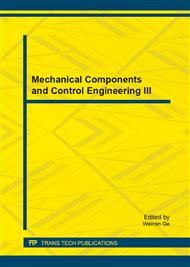[1]
Vapnik V N. The Nature of Statistical Learning Theory . New York: Springer, (1996).
Google Scholar
[2]
Jayadeva, Khemchanani R., Chandra S. Twin Support Vector Machines for pattern classification . IEEE Trans. PatternAna. Machine Intell, May. 2007, 29(5): 905-910.
DOI: 10.1109/tpami.2007.1068
Google Scholar
[3]
M. Arun Kumar,M. Gopal. Least squares twin Support Vector Machines for pattern classification, Expert Systems with Applications, 2009, 36: 7535-7543.
DOI: 10.1016/j.eswa.2008.09.066
Google Scholar
[4]
Xinbin Zhao, Haifa Shi, Meng Lv, Ling Jing. Least Squares Twin Support Tensor Machine For Classification. Journal of Information and Computational Science, Vol 11, No12, (2014).
DOI: 10.1049/cp.2013.2274
Google Scholar
[5]
D. Cai, X.F. He, J.R. Wen, J. Han and W.Y. Ma. Support Tensor Machines for Text Categorization. Department of Computer Science Technical Report No. 2714. University of Illinois at Urbana-Champaign , April (2006).
Google Scholar
[6]
X.S. Zhang, X.B. Gao, Y. Wang. Twin support tensor machines for MCs detection. Journal of Electronics, 2009, 3(26): 318-325.
DOI: 10.1007/s11767-007-0211-0
Google Scholar
[7]
Liwei Wang, Yan Zhang, Jufu Feng, On the Euclidean Distance of Images. IEEE Transactions on pattern analysis and machine intelligence, Vol. 27, No. 8, August (2005).
DOI: 10.1109/tpami.2005.165
Google Scholar
[8]
Yang Liu, Yan Liu, and Keith C.C. Chan, Tensor Distance Based Multilinear Locality-Preserved Maximum Information Embedding. IEEE Transactions on neural networks, Vol. 21, No. 11, Novermber.
DOI: 10.1109/tnn.2010.2066574
Google Scholar
[9]
H. Wang, S. Chen, Z. Hu, and W. Zheng, Locality-preserved maximum information projection, IEEE Trans. Neural Netw., vol. 19, no. 4, p.571–585, Apr. (2008).
DOI: 10.1109/tnn.2007.910733
Google Scholar
[10]
Xinjun Peng, Dong Xu, Twin Mahalanobis distance-based support vector machines for pattern recognition. Information Sciences 200 (2012) 22–37.
DOI: 10.1016/j.ins.2012.02.047
Google Scholar
[11]
UCI Machine Learning Repsository. http: /archive. ics. uci. edu/ml/datasets. html.
Google Scholar
[12]
AT&T Labs Cambridge (1994) The Olivetti and Oracle Research Laboratory database of faces. http: /www. cl. cam. ac. uk/research/dtg/attarchive/facedatabase. html.
Google Scholar


